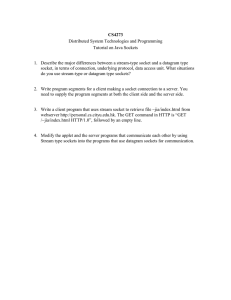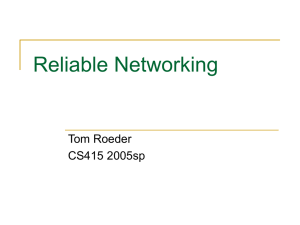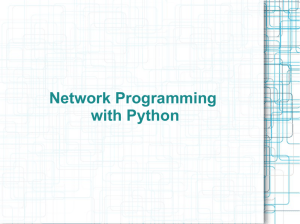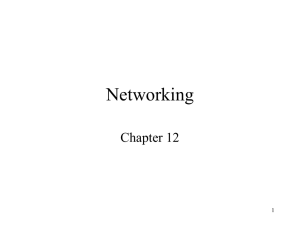Socket programming Goal: Socket API socket
advertisement
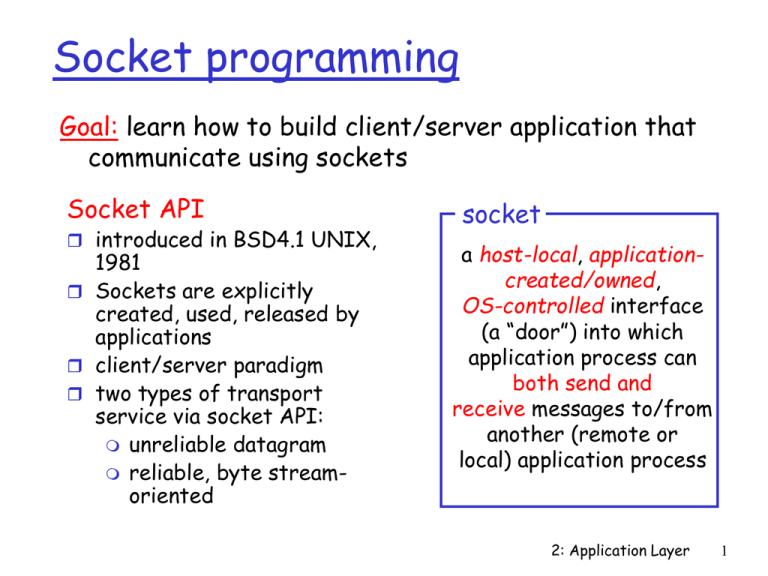
Socket programming
Goal: learn how to build client/server application that
communicate using sockets
Socket API
introduced in BSD4.1 UNIX,
1981
Sockets are explicitly
created, used, released by
applications
client/server paradigm
two types of transport
service via socket API:
unreliable datagram
reliable, byte streamoriented
socket
a host-local, applicationcreated/owned,
OS-controlled interface
(a “door”) into which
application process can
both send and
receive messages to/from
another (remote or
local) application process
2: Application Layer
1
Sockets
Socket: a door between application process
and end-end-transport protocol (UCP or
TCP)
controlled by
application
developer
controlled by
operating
system
process
process
socket
kernel
buffers,
variables
host or
server
internet
socket
kernel
buffers,
variables
controlled by
application
developer
controlled by
operating
system
host or
server
2: Application Layer
2
Languages and Platforms
Socket API is available for many languages on
many platforms:
C, Java, Perl, Python,…
*nix, Windows,…
Socket Programs written in any language and
running on any platform can communicate
with each other!
2: Application Layer
3
Socket Programming is Easy
Create socket much like you open a file
Once open, you can read from it and write
to it
Operating System hides most of the
details
2: Application Layer
4
Decisions
Before you go to write socket code, decide
Do you want a TCP-style reliable, full duplex,
connection oriented channel? Or do you want a
UDP-style, unreliable, message oriented
channel?
Will the code you are writing be the client or
the server?
• Client: you assume that there is a process already
running on another machines that you need to connect
to.
• Server: you will just start up and wait to be
contacted
2: Application Layer
5
Socket programming with TCP
Client must contact server
server process must first
be running
server must have created
socket (door) that
welcomes client’s contact
Client contacts server by:
creating client-local TCP
socket
specifying IP address, port
number of server process
When client creates socket:
client TCP establishes
connection to server TCP
When contacted by client,
server TCP creates new
socket for server process to
communicate with client
Frees up incoming port
allows server to talk with
multiple clients
application viewpoint
TCP provides reliable, in-order
transfer of bytes (“pipe”)
between client and server
2: Application Layer
6
Pseudo code TCP server
Create socket (doorbellSocket)
Bind socket to a specific port where clients can
contact you
Register with the kernel your willingness to listen
that on socket for client to contact you (if didn’t
bind, listen would choose an ephemeral port)
Loop
Accept new connection (connectSocket)
Read and Write Data Into connectSocket to
Communicate with client
Close connectSocket
Close doorbellSocket
2: Application Layer
7
Pseudo code TCP client
Create socket, connectSocket
Do an active connect specifying the IP
address and port number of server
Loop
Read and Write Data Into
connectSocket to Communicate
with server
Close connectSocket
2: Application Layer
8
Client/server socket interaction: TCP
(Java)
Server (running on hostid)
Client
create socket,
port=x, for
incoming request:
welcomeSocket =
ServerSocket()
TCP
wait for incoming
connection request connection
connectionSocket =
welcomeSocket.accept()
read request from
connectionSocket
write reply to
connectionSocket
close
connectionSocket
setup
create socket,
connect to hostid, port=x
clientSocket =
Socket()
send request using
clientSocket
read reply from
clientSocket
close
clientSocket
2: Application Layer
9
Example: Java server (TCP)
import java.io.*;
import java.net.*;
class TCPServer {
Create
welcoming socket
at port 6789
Wait, on welcoming
socket for contact
by client
Create input
stream, attached
to socket
public static void main(String argv[]) throws Exception
{
String clientSentence;
String capitalizedSentence;
ServerSocket welcomeSocket = new ServerSocket(6789);
while(true) {
Socket connectionSocket = welcomeSocket.accept();
BufferedReader inFromClient =
new BufferedReader(new
InputStreamReader(connectionSocket.getInputStream()));
2: Application Layer
10
Example: Java server (TCP), cont
Create output
stream, attached
to socket
DataOutputStream outToClient =
new DataOutputStream(connectionSocket.getOutputStream());
Read in line
from socket
clientSentence = inFromClient.readLine();
capitalizedSentence = clientSentence.toUpperCase() + '\n';
Write out line
to socket
outToClient.writeBytes(capitalizedSentence);
}
}
}
End of while loop,
loop back and wait for
another client connection
2: Application Layer
11
Example: Java client (TCP)
import java.io.*;
import java.net.*;
class TCPClient {
public static void main(String argv[]) throws Exception
{
String sentence;
String modifiedSentence;
Create
input stream
Create
client socket,
connect to server
Create
output stream
attached to socket
BufferedReader inFromUser =
new BufferedReader(new InputStreamReader(System.in));
Socket clientSocket = new Socket("hostname", 6789);
DataOutputStream outToServer =
new DataOutputStream(clientSocket.getOutputStream());
2: Application Layer
12
Example: Java client (TCP), cont.
Create
input stream
attached to socket
BufferedReader inFromServer =
new BufferedReader(new
InputStreamReader(clientSocket.getInputStream()));
sentence = inFromUser.readLine();
Send line
to server
outToServer.writeBytes(sentence + '\n');
Read line
from server
modifiedSentence = inFromServer.readLine();
System.out.println("FROM SERVER: " + modifiedSentence);
clientSocket.close();
}
}
2: Application Layer
13
Socket programming with UDP
UDP: very different mindset
than TCP
no connection just
independent messages sent
no handshaking
sender explicitly attaches
IP address and port of
destination
server must extract IP
address, port of sender
from received datagram to
know who to respond to
application viewpoint
UDP provides unreliable transfer
of groups of bytes (“datagrams”)
between client and server
UDP: transmitted data may be
received out of order, or
lost
2: Application Layer
14
Pseudo code UDP server
Create socket
Bind socket to a specific port where clients
can contact you
Loop
(Receive UDP Message from client x)+
(Send UDP Message to client x)*
Close Socket
2: Application Layer
15
Pseudo code UDP client
Create socket
Loop
(Send Message To Well-known port of
server)+
(Receive Message From Server)
Close Socket
2: Application Layer
16
Client/server socket interaction: UDP
Server (running on hostid)
create socket,
port=x, for
incoming request:
serverSocket =
DatagramSocket()
read request from
serverSocket
write reply to
serverSocket
specifying client
host address,
port umber
Client
create socket,
clientSocket =
DatagramSocket()
Create, address (hostid, port=x,
send datagram request
using clientSocket
read reply from
clientSocket
close
clientSocket
2: Application Layer
17
Example: Java client (UDP)
import java.io.*;
import java.net.*;
Create
input stream
Create
client socket
Translate
hostname to IP
address using DNS
class UDPClient {
public static void main(String args[]) throws Exception
{
BufferedReader inFromUser =
new BufferedReader(new InputStreamReader(System.in));
DatagramSocket clientSocket = new DatagramSocket();
InetAddress IPAddress = InetAddress.getByName("hostname");
byte[] sendData = new byte[1024];
byte[] receiveData = new byte[1024];
String sentence = inFromUser.readLine();
sendData = sentence.getBytes();
2: Application Layer
18
Example: Java client (UDP), cont.
Create datagram
with data-to-send,
length, IP addr, port
DatagramPacket sendPacket =
new DatagramPacket(sendData, sendData.length, IPAddress, 9876);
Send datagram
to server
clientSocket.send(sendPacket);
Read datagram
from server
clientSocket.receive(receivePacket);
DatagramPacket receivePacket =
new DatagramPacket(receiveData, receiveData.length);
String modifiedSentence =
new String(receivePacket.getData());
System.out.println("FROM SERVER:" + modifiedSentence);
clientSocket.close();
}
}
2: Application Layer
19
Example: Java server (UDP)
import java.io.*;
import java.net.*;
Create
datagram socket
at port 9876
class UDPServer {
public static void main(String args[]) throws Exception
{
DatagramSocket serverSocket = new DatagramSocket(9876);
byte[] receiveData = new byte[1024];
byte[] sendData = new byte[1024];
while(true)
{
Create space for
received datagram
Receive
datagram
DatagramPacket receivePacket =
new DatagramPacket(receiveData, receiveData.length);
serverSocket.receive(receivePacket);
2: Application Layer
20
Example: Java server (UDP), cont
String sentence = new String(receivePacket.getData());
Get IP addr
port #, of
sender
InetAddress IPAddress = receivePacket.getAddress();
int port = receivePacket.getPort();
String capitalizedSentence = sentence.toUpperCase();
sendData = capitalizedSentence.getBytes();
Create datagram
to send to client
DatagramPacket sendPacket =
new DatagramPacket(sendData, sendData.length, IPAddress,
port);
Write out
datagram
to socket
serverSocket.send(sendPacket);
}
}
}
End of while loop,
loop back and wait for
another datagram
2: Application Layer
21
Server vs Client
In UDP case, little difference
Server has well known port and receives first
Client send first
In TCP case, more difference
Still server has well know port
Server waits for connection on well known port
Clients initiates connection
2: Application Layer
22
Concurrent Servers
Parent process creates the “door bell”
socket on well-known port and waits for
clients to request connection
When a client does connect, fork off a
child process to handle that connection so
that parent process can return to waiting
for connections as soon as possible
Multithreaded server: same idea, just
spawn off another thread rather than a
full process
Threadpools?
2: Application Layer
23
Backlog
Many implementations do allow a small
fixed number (~5) of unaccepted
connections to be pending, commonly called
the backlog
This helps avoid missing connections while
process not sitting in the accept call
2: Application Layer
24
Pseudo code concurrent TCP
server
Create socket doorbellSocket
Bind
Listen
Loop
Accept the connection, connectSocket
Fork
If I am the child
Loop
Read/Write connectSocket
Close connectSocket
exit
Close doorbellSocket
2: Application Layer
25
Credit:
CAIDA (1999)
Real Internet Traffic Analysis
2: Application Layer
26
On to the transport layer…
Important to remember that we build
transport services to support applications
Transport services are a means to an end
2: Application Layer
27
Transport service requirements of common apps
Data loss
Bandwidth
Time Sensitive
file transfer
e-mail
Web documents
real-time audio/video
no loss
no loss
loss-tolerant
loss-tolerant
no?
no
no?
yes, 100’s msec
stored audio/video
interactive games
news
loss-tolerant
loss-tolerant
elastic
elastic
elastic
audio: 5Kb-1Mb
video:10Kb-5Mb
same as above
few Kbps up
elastic
Application
No loss ?
yes, few secs
yes, 100’s msec
no
2: Application Layer
28
Internet apps: their protocols and transport
protocols
Application
e-mail
remote terminal access
Web
file transfer
streaming multimedia
remote file server
Internet telephony
DNS
Application
layer protocol
Underlying
transport protocol
smtp [RFC 821]
telnet [RFC 854]
http [RFC 2068]
ftp [RFC 959]
RTP, proprietary
(e.g. RealNetworks)
NFS
proprietary
(e.g., Vocaltec)
DNS
TCP
TCP
TCP
TCP
UDP
TCP or UDP
typically UDP
typically UDP, TCP
2: Application Layer
29

